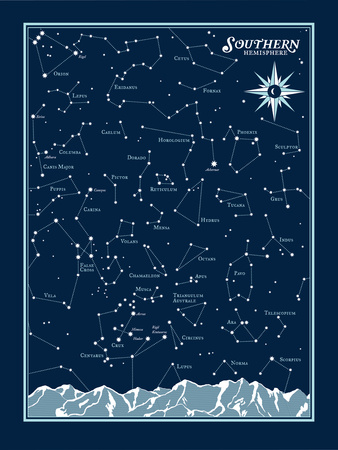Astronomy defines the Southern sky as the half of the celestial sphere that is south of the celestial Equator.
The Earth's axial tilt is responsible for the celestial Equator's inclination by 23.4° with respect to the ecliptic plane.
axial tilt (or obliquity), rotation axis, plane of orbit, celestial equator and ecliptic; Earth viewed from Sun: Dennis Nilsson, CC BY 3.0, via Wikimedia Commons @ https://commons.wikimedia.org/wiki/File:AxialTiltObliquity.png
Southern Pinwheel Galaxy, also known as Messier 83, M83, or NGC 5236, is visible with binoculars.
On February 23, 1752, French astronomer Abbé Nicolas Louis de La Caille (December 28, 1713 – March 21, 1762) discovered the barred spiral galaxy at the Cape of Good Hope.
Southern Pinwheel Galaxy, distanced 15 million light years, in Hydra the Sea Serpent constellation; image released Jan. 9, 2014: NASA, ESA, and the Hubble Heritage Team (STScI/AURA); Acknowledgement William Blair (Johns Hopkins University), Public Domain, via Wikimedia Commons @ https://commons.wikimedia.org/wiki/File:Hubble_view_of_barred_spiral_galaxy_Messier_83.jpg
Milky Way Galaxy and the pōhutukawa (Metrosideros excelsa), also known as New Zealand Christmas tree
Okato, Taranaki, western North Island, New Zealand: Dave Young (dcysurfer / Dave Young), CC BY 2.0, via Flickr @ https://www.flickr.com/photos/dcysurfer/14783345783/
Eta Carinae is surrounded by Homunculus Nebula, a bipolar (bi-lobed) reflection nebula that in turn is embedded with the Eta Carinae nebula.
Image was taken through red and near-ultraviolet filters to capture the dynamic range of central star glaring 100,000 times more brightly than the faint outer ejecta blobs.
Hubble's Wide Field and Planetary Camera 2 (WFPC2), September 1995: Nathan Smith (University of California, Berkeley), and NASA, Public Domain, via Wikimedia Commons @ https://commons.wikimedia.org/wiki/File:EtaCarinae.jpg
Eta Carinae nebula: never visible north of 30°North latitude; visible circumpolar south of 30°South latitude
Namesake blinding star at nebula's center has mass 100 times that of Earth's Sun; the star's infrared light destroys particles of nebular dust, sculpting cavities and leaving pillars of denser material pointing back to the star.
the tortured clouds of Eta Carinae, viewed from NASA’s Spitzer Space Telescope: NASA/JPL-Caltech, Public Domain, via Wikimedia Commons @ https://commons.wikimedia.org/wiki/File:The_Tortured_Clouds_of_Eta_Carinae.jpg















 Are Hawaiian Huakai Po Nightmarchers Avenging Halloween Thursday?on 10/02/2024
Are Hawaiian Huakai Po Nightmarchers Avenging Halloween Thursday?on 10/02/2024
 Mailing Addresses for 2023 Form 4868 Extending 1040 and 1040SR April 15, 2024, Due Dateon 04/15/2024
Mailing Addresses for 2023 Form 4868 Extending 1040 and 1040SR April 15, 2024, Due Dateon 04/15/2024
 Mailing Addresses for 2023 Forms 1040 and 1040SR Filed in 2024on 04/15/2024
Mailing Addresses for 2023 Forms 1040 and 1040SR Filed in 2024on 04/15/2024
 Mailing Addresses for 2022 Form 4868 Extending 1040 and 1040SR April 18, 2023, Due Dateon 04/13/2023
Mailing Addresses for 2022 Form 4868 Extending 1040 and 1040SR April 18, 2023, Due Dateon 04/13/2023



Comments